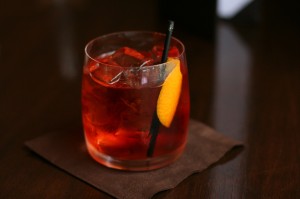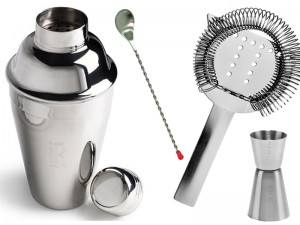Come si fa il Negroni? La ricetta e la vera storiaHow do the Negroni? The recipe and the real story
Un bartender sulle tracce del conte Negroni, fra mito e leggenda, alla ricerca delle origini del drink più aristocratico del mondo
Se fosse un drink, la ricetta sarebbe un terzo di cultura, un terzo di curiosità e un terzo di tenacia. È Luca Picchi, il bar manager dello storico Caffè Rivoire di Firenze, che si è messo sulle tracce dell’origine del Negroni cocktail, per smentire che l’attribuzione di paternità all’omonimo conte fosse solo leggenda. Dopo anni di ricerche, Picchi ha messo nero su bianco queste sue scoperte, con il libro edito da Giunti, “Negroni cocktail, una leggenda italiana”. Così, come l’indagine di un “cold case” di altri tempi, il bartender toscano ha setacciato archivi e biblioteche, ha frequentato cimiteri di Firenze e provincia, fino a trovare la pista giusta e ricostruire la vera storia del conte Camillo Negroni e del cocktail a lui intitolato.
Ebbene sì, il conte è esistito davvero, vissuto fra gli Stati Uniti (e nella fattispecie per un periodo ha vissuto a New York, al tempo della Golden Age of Cocktails) e Firenze, dove è nato nel 1868 ed è tornato dopo l’esilio americano nel 1912, per morire nel 1934. Non ci si stupirebbe se su di lui facessero un film: rampollo agiato, quanto agitato, Negroni è stato cowboy, maestro di scherma, giocatore d’azzardo e frequentatore tanto di salotti, quanto di bar di ogni tipo, dal Grand Hotel alla Drogheria Casoni. Ed è proprio in quest’ultimo che la leggenda racconta che il conte abbia dettato a Fosco Scarselli, il suo barista di fiducia, in un giorno imprecisato fra 1917 e 1920, la ricetta del Negroni: un terzo di vermouth rosso, un terzo di bitter e un terzo di gin.

Non sappiamo come sia morto il conte, ma non stupirebbe se fosse stato tradito dal suo fegato. Fra i documenti rinvenuti da Picchi, una lettera con la raccomandazione di non bere più di 20 Negroni al giorno, oltre alla testimonianza in un’intervista del ’62 dello stesso Fosco Scarselli che affermava: “Il conte era un gran bevitore. C’erano dei giorni che riusciva a inghiottire anche quaranta drink, eppure non lo vidi mai ubriaco”. A discolpa del conte, si ritiene che la dimensione di tali drink non fosse quella di un tumbler, il bicchiere in cui siamo abituati a vederlo oggigiorno, quanto più verosimilmente un calicino da cordiale.
Con gli anni, non sono cambiati solo i bicchieri per il servizio, ma le modifiche (i twist, come li chiamano gli addetti ai lavori) al cocktail Negroni si sprecano. Luca Picchi ha sapientemente ripercorso tutti gli elementi di un buon Negroni e ha chiamato a raccolta amici e colleghi, per una carrellata di twist, con relative ricette.
Tuttavia, anche quella ricetta così semplice, “un terzo, un terzo, un terzo”, non è così scontata. «L’unica costante – spiega Picchi – è il Campari, ovvero il bitter, mentre sia il sapore del vermouth che del gin dipende fortemente dai botanical con cui sono aromatizzati. Bisogna assaggiarli e decidere come bilanciarli, per ottenere l’equilibrio più appropriato a esaltare i loro profumi». E non può mancare il personale twist di Picchi, il Negroni Insolito, che propone un passaggio in un colino con chicchi di caffè, che rilasciano il loro sentore al drink e ben si accompagnano a una scorzetta d’arancia.

Ricetta Negroni
30 ml Gordon’s Gin
30 ml Bitter Campari
30 ml Martini Riserva Speciale rubino
splash di Club soda (optional)
Raffreddare il bicchiere (tumbler) con cubetti o tagli di ghiaccio pieni, eliminando l’acqua con lo strainer o passino, dosare gli ingredienti direttamente nel bicchiere con il jigger, mescolare con il barspoon e servire con una fetta d’arancia.
Negroni insolito
15 ml Oxeley Gin
15 ml Bitter Campari
15 ml Americano Cocchi
10 ml China Clementi
gocce di Orange Bitter
chicchi di caffè
Raffreddare sia un bicchiere da cocktail che un mixing glass con cubetti o tagli di ghiaccio pieni, eliminando l’acqua con lo strainer o passino; dosare gli ingredienti liquidi con il jigger nel mixing glass e far passare il drink 3 o 4 volte in un colino con chicchi di caffè appena tostati. Con questa tecnica, denominata percolazione, i chicchi rilasciano un leggero aroma al drink. Infine versare dal mixing glass al bicchiere con lo strainer e servire con scorza d’arancia.
Fonte: lacucinaitaliana.it
A bartender in the footsteps of the Earl Negroni, between myth and legend, in search of the origins of the most aristocratic drink of the world.
If it were a drink, the recipe would be a third culture, a third of curiosity and a third of tenacity. Is Luca Picchi, the bar manager of the historical Café Rivoire in Florence, which was put on the traces of the origin of Negroni cocktail, to deny that the authorship attribution of eponymous Earl was just legend. After years of research, Picchi has put on paper these discoveries, the book published by Giunti, “Negroni cocktail, an Italian legend”. So, as the investigation of a “cold case” of other times, the bartender Tuscan has scoured archives and libraries, attended cemeteries in Florence and the province, to find the right track and reconstruct the true story of the Earl Camillo Negroni and cocktail named after him.
Yes, the Earl is really existed, lived in the United States (and in this case for a period he lived in New York, during the Golden Age of Cocktails) and Florence, where he was born in 1868 and returned after the American exile in 1912, dying in 1934. Do not be surprised if you should make a film about him: wealthy scion, as agitated, Negroni was cowboy, fencing master, gambler and frequenter of salons, bars of all kinds, from the Grand Hotel to the grocery Casoni. It is in the latter that the legend says that the Earl has dictated to Fosco Scarselli, his bartender of trust, in a imprecise day between 1917 and 1920, the Negroni recipe: one third of red vermouth, a third of bitter and a third of gin.

We do not know how he died, but do not be surprised if he had been betrayed by his liver. Among the documents found by Picchi, a letter with the recommendation not to drink more than 20 Negroni per day, in addition to the testimony of the same Fosco Scarselli, in an ’62 interview, stated that: “The Earl was a heavy drinker. There were days that could swallow even forty drink, but I never saw him drunk”. In defense of the Earl, it is believed that the size of these drinks is not that of a tumbler, a glass in which we are accustomed to seeing him today, the more likely a little cordial glass.
Over the years, not only have changed the glasses for the service, but modifications (the twist, as they call the experts) to Negroni cocktails abound. Luca Picchi has carefully traced all the elements of a good Negroni and has brought together friends and colleagues for a roundup of twist, with its recipes.
However, even that recipe so simple, “one-third, one third, one third,” is not so obvious. “The only constant – explains Picchi – is the Campari, or Bitter, while both the taste of gin and of vermouth heavily depends on botanicals which are flavored. You have to taste it and decide how to balance them, in order to obtain the appropriate balance to enhance their fragrance. “And of course the personal twist of Picchi, the Unusual Negroni, which offers a ride in a colander with coffee beans, which release their scent to the drink and well matched to an orange rind.

Negroni recipe
30 ml Gordon’s Gin
30ml Bitter Campari
30 ml Martini Special Reserve ruby
splash of club soda (optional)
Cool the glass (tumbler) with cubes of ice full or cutted, eliminating the water with the strainer, measure out the ingredients directly into the glass with the jigger, mixing with the barspoon and serve with a slice of orange.
Unusual Negroni
15 ml Oxeley Gin
15 ml Bitter Campari
15 ml Americano Cocchi
10 ml China Clementi
drops of Orange Bitter
coffee beans
Cooling both a cocktail glass that a mixing glass with ice cubes, removing the water with the strainer; measure out the liquid ingredients in a mixing glass with jigger and pass the drink 3 or 4 times in a colander with freshly roasted coffee beans. With this technique, called percolation, the beans release a light aroma to the drink. Finally pour from the mixing glass to the glass with the strainer and serve with orange zest.
Source: lacucinaitaliana.it





Leave a comment